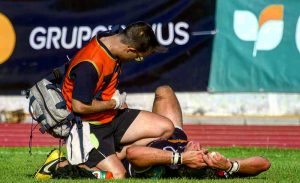
Patellofemoral pain or Runner’s knee
May 27, 2019
The most common injury mistake
June 9, 2019
The main objective of this article is that you understand what is pain, the pain experience and how can you help yourself and your therapist through the process of recovery, either there’s an acute or chronic state, a traumatic or insidious episode. But the most important factor, the one you should retain is that your body is strong and can adapt through all circumstances.
Everything is going to be okay!
But, what is that damn trigger that sparkles in our body when we experience some threatening episode?
PAIN can be described as an unpleasant sensory and emotional experience regarding an actual or potential damage to the body that is influenced by our emotions, sensations, cognition and social experience. In our body we have some sensors, the nociceptors, responsible for tracking any potential danger to our body and send that information to our brain that it will make an interpretation regarding our own experiences, beliefs and actual feedback from our tissues.
But why do we get pain?
The main objective is to protect us from getting more harm or reduce the exposure of a potential threat. Pain is an alarm that our body creates in order to take action.
In an acute state, pain is a good sense of awareness that protects you against harm (ex: extreme pain after ankle sprain) but over the long run the body adapts to this sensation of pain, becoming chronic in nature and no longer alarms to the presence of persisting threats
Pain doesn’t mean you have to stop doing most of the things you enjoy, but overtime can take you to a state of over-protection. Hence, you can always modify your training or de-load a workout that best suits your body whilst recovering from pain or injury, AKA: Active Recovery
What can you do to recover and relieve pain?
- First of all, try not to panic. Everybody experiences pain and most of the cases the process can be resolved with some good exercises and healthy habits.
- Try to find which factor(s) trigger or provoke your pain.
- If you can’t do it yourself, work with your healthcare professional in order to determine why you are experiencing pain and what strategies you can build to decrease that state of awareness and eliminate the cause or origin of pain
- Add some healthy habits that can help you decrease your symptoms and prevent further pain or injury
- General exercise or physical activity (Ex: start walking or swimming)
- Go back to activities you like
- Build healthy sleeping habits
- Build healthy eating habits
- Maintain proper sitting and sleeping postures
- Do anything that makes you happy
- Enjoy your success
Everyone talks about physical activity!
Physical activity is more than just working out at gym or running; its that little extra mile you take more than you do at work; it’s taking the stairs instead of the lift and enjoying the nature surrounding you. Physical activity doesn’t only have an impact on pain, it influences your heart, lungs, bones, joints and stimulates your brain. It improves your tolerance to all stressful factors and will help you slowly construct the healthier and pain free YOU that you need.
Our opinion
There’s no magic pill; exercise is definitely one form of therapy towards helping yourself always feel better, stay pain-free and prevent injury. The road to recovery is long but when you get there, that feeling of being healthy and well is like no other. The change in your lifestyle habits start with you.
Start slow, start somewhere as you make your way to a healthier better lifestyle and make sure you visit and seek answers for all your questions from your healthcare professional.
Joao L.
[ad_2]
Source link




